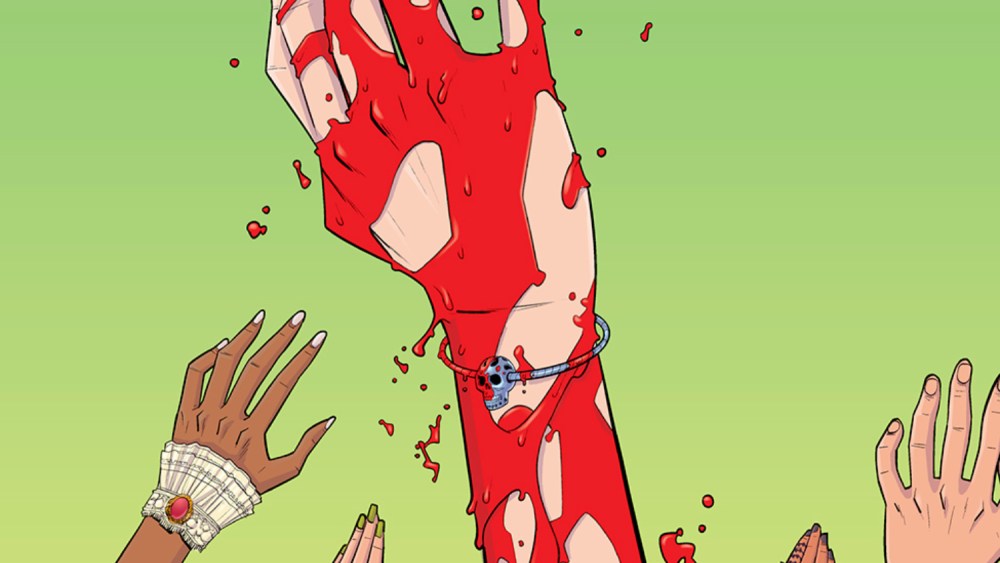Like the first day of school, a new #1 issue can be an exciting but nerve-wracking process. It would only make sense, then, that the same would hold true for Rennie Bethary in I Was A Fashion School Serial Killer.
Despite the pedigree of writer Doug Wagner and artist Daniel Hillyard (and joined by colorist Michelle Madsen), Ms. Bethary’s early days of fashion school were novel enough (the setting, the premise, etc.) if also just a touch uneven (the sitcom-ification can still go either way, and the violence has felt a little one note-ish). I Was A Fashion School Serial Killer clearly had heaps of potential, but the margin for success was seemingly going to be narrow enough.
Luckily, issue #2 made big moves to set up I Was A Fashion School Serial Killer for extra bloody payoff.

Variant cover by Daniel Hillyard. Courtesy of Image Comics.
In some ways, issue #2 leaned into both the ups and downs of issue #1. So that meant we got both college dudes being dispatched (like an urban spin on Predator) as much as we got a lot of cutesy interplay between Rennie and her new BFF, Sofie. The real difference, then, is that after issue #1 basically laid out the world of I Was A Fashion School Serial Killer, issue #2 positioned things in a way to help the overarching story coalesce.
Which is to say, Rennie gloriously soaking in a bathtub of blood (twice in one issue, boom!) wasn’t just about shock value. No, we get a much better sense of what it offers her — not only in addressing her physical and psychological “itch,” but the kind of focus and direction it offers her burgeoning work as a fashion designer and how it allows her to finally feel normal/grounded.
Not enough of that dynamic was stated outright in issue #1, and so getting a decidedly clearer sense through her words (where more of Rennie’s humanity shines through) and through the world of this book (we got more genuinely charming, slice-of-life stuff during a movie date with friends) truly and fully mattered. It grounded and contextualized a lot of Rennie’s experiences, and we see her coming into her own a bit more as issue #2 plays out.

Courtesy of Image Comics.
She’s not the anxious, nervous weirdo of issue #1 — she’s the increasingly warm and engaging weirdo who can murder folks, nail her assignment, and still make time for her pals. It’s ultimately a chance to push the book’s whole premise into a gear that removes some of the gimmickry (which is where the whole “sitcom sheen” felt a little tenuous) and instead lets the gimmick settle in a way that demands our immersion.
Rennie’s whole thing feels far less theoretical right now — a montage approach in this issue really helped with pacing and leaning into certain story devices necessary for this book’s success — and she’s even more real. She was quite compelling in #1, but now I’m rooting her that much more. She’s less of a spectacle, and it just took a few liters of blood and some great moments with Sofie to really make this all happen.
Of course, then the question begs: Where are we headed with all of this? This issue felt like that moment in most ’90s comedies, for instance, where the weirdo hero finally starts to click with friends/job/etc. until some moment causes all of that to fall apart as quickly as it came together. I’m not sure if Rennie has a Tommy Boy-esque experience in her future, but this whole structure 1) brilliantly adds to and extends what the creators are doing tonally (again, sitcoms) and 2) brings her to life in a way that we (justly) either want to see her tenuous world crumble or we’re hoping this serial killer can somehow avoid her truly deserved fate.

Courtesy of Image Comics.
Either way, it makes us really work through our relationship with Rennie, and in that way Wagner and Hillyard are making good on books like Plush and Plastic — to see how others operate in the world and really make us question or re-engage with our own morals, politics, and interpersonal connections.
In past books (to use Plastic yet again), Wagner and Hillyard really wanted to shock us into this process via ample gore. And, while that’s still a key part of I Was A Fashion School Serial Killer, it also just feels different. The gore isn’t solely about shocking us (like when a dude’s nearly beheaded with a necklace in glorious manner), but rather it augments how we’re meant to engage with Rennie.
Violence isn’t the thing that, for instance, complicates Edwyn’s own development — it lets us see Rennie at her best/most personable/creative. If Edwyn is a lovable loser then wildly complicated by his illness and violent tendencies, Rennie is a monster made increasingly, undeniably human through hers.
And in that way, we’re meant to see all this endless bloodshed not as augmenting and modifying our experience and relationships, but rather facilitating it in the first place. It’s when we invite in said violence, often with robust joy and humanity, that we really begin to question our connection with Rennie, how far we’re willing to follow her arc, and what that means for our role as people in a world where you can’t just hack and slash your way to a better life (no matter how much you may desire that very prospect).

Courtesy of Image Comics.
There’s a moment in this issue where a teacher tells Rennie to “keep evolving” in her design work. And that concept is very much applied to all aspects of her life — she’s finding her needs met the more she embraces who she is deep down. But the same can be true for our experience with I Was A Fashion School Serial Killer. The creators are giving us the right connective potential to follow them, and they’re making us feel these deep connections just as much as we’re meant to question their value and their corresponding price. It’s a subtle but powerful gesture, and something that really opens this book up in a massive way.
There’s still some issues — certainly some of those from #1 mentioned, but also if Sofie can be regarded as a real girl and not just a prop in Rennie’s world. But those concerns are still threads in a killer sweater being crafted by the creators. A lil’ wool number that demands to be worn, and pokes us with stray threads to get us to truly think about ideas of friendship, fitting in, violence in an unjust world, and if we’re born who we are or if we become that (and what power or say do we have?) There’s still more sewing to be done, and the whole design could still fall apart if certain things don’t happen (for instance, Rennie must have that big moment where it all falls apart or nothing can be gained).
But for now, issue #2 of I Was A Fashion School Serial Killer deserves at least a B+, a smiley face sticker, and the note/comment, “Let’s push this as big and boldly as we possibly can.”



